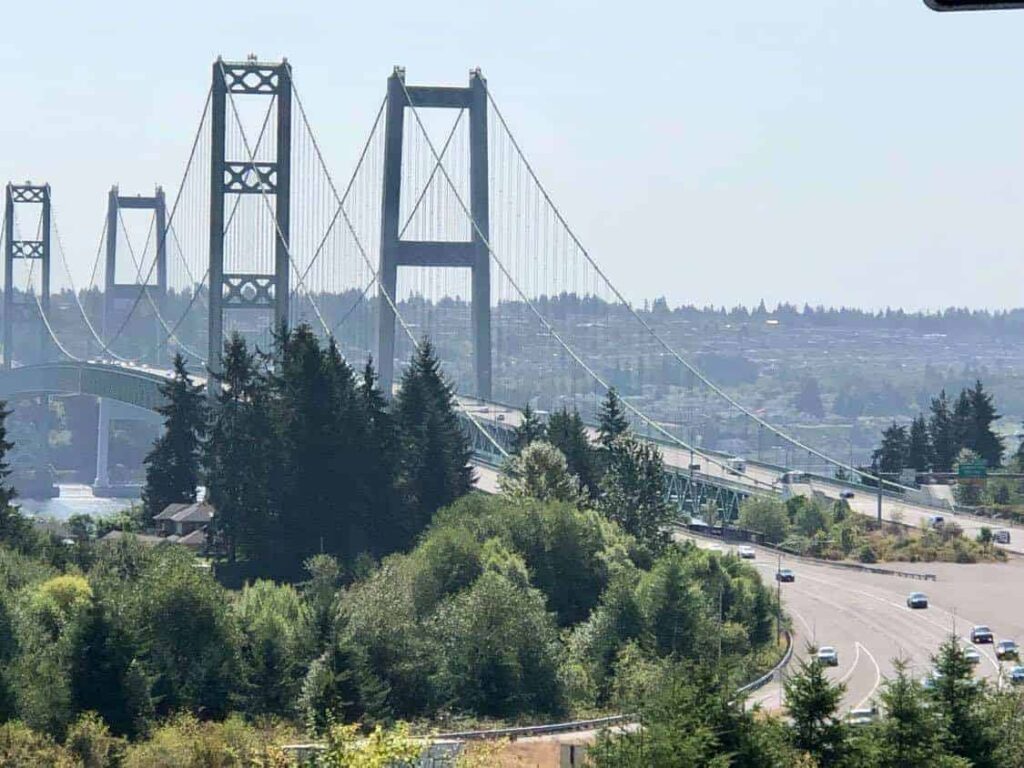Government Transportation
Legislation proposes to pay off Tacoma Narrows Bridge, remove tolls
Tolls would be entirely removed from the Tacoma Narrows Bridge in a year and a half if a bill pre-filed Monday morning is passed by the Washington State Legislature. The 2022 short session will run 60 days from Jan. 10 to March 10.
Sen. Emily Randall, D-Bremerton, is proposing in Senate Bill 5488 that $772 million be transferred from the general fund to pay off debts on the bridge that opened on July 16, 2007. It would include $672 million for outstanding principal and interest, $57 million for deferred sales taxes on the bridge’s construction and $43 million loaned by the state to freeze toll rates.

Bills were pre-filed in the state Senate and House Monday to pay off remaining costs of the Tacoma Narrows Bridge in the summer of 2023 and remove tolls. Ed Friedrich / Gig Harbor Now
With interest, the bridge’s $729 million construction cost balloons to more than $1.48 billion. That debt would be satisfied on June 30, 2030. The $57.6 million in deferred sales tax was originally required to be added in 10 annual installments beginning in 2019, but lawmakers bumped it until after the bonds were paid, to limit toll increases. That would be followed by repayment of the $42.8 million in state loans by Fall 2031, at which time, by state law, tolls would be removed, according to Carl See, deputy director of the state Transportation Commission, which determines toll rates.
Unlike any other state transportation project, toll payers are responsible for virtually the entire bridge cost. They have paid about $708 million in the first 14 years.
“I know it’s a lot of money, but I think there’s a lot of shared interest in paying off a key infrastructure project that was poorly financed in the first place,” Randall said of the request. “Our constituents on the peninsula and in Tacoma should to be able to move around the region without carrying the entirety of the debt.”
The projection this year is that, after a dip in traffic because of the pandemic, 15.6 million vehicles will cross the new eastbound bridge, producing gross revenue of $84 million, See said. Tolls are not paid going westbound on the old 1950 span.
Current rates are $5.25 with a Good To Go! pass, $6.25 at the toll booths and $7.25 for pay by mail. Overall, tolls have remained near what was originally projected. Before the bridge was built, the Department of Transportation published a preliminary toll schedule that placed tolls at $3 the first year, $4 the following three years, $5 the next three, and $6 for the final 15 years. Toll revenue can only cover debt payments, operations and maintenance costs.
In 2018, a work group led by Rep. Jesse Young, R-Gig Harbor, and Rep. Jake Fey, D-Tacoma, proposed that the state contribute up to $125 million outright toward the Narrows Bridge. Lawmakers balked, but agreed to loan the bridge fund up to $85 million to freeze tolls after a 25-cent increase in October. This bill is asking for a much larger sum.
“We have a good budget outlook this year on the operating side,” Randall said. “We have a significant amount of federal money. And I think what we’ve learned is if we don’t pay it off sooner rather than later we’re going to have to pay off so much more in the long run.”
“I’m sure we’ll have many conversations over the course of the session about other possibilities, but I think you have to set out the boldest plan because you certainly don’t get what you don’t ask for.”
The state will receive federal infrastructure money and still has unspent COVID funds, Randall said. November numbers from the state Economic and Revenue Forecast Council show that projected revenue collections for the 2021-2023 budget cycle ending June 30, 2023, are $898 million more than what had been forecasted in September and are now projected to be $60.2 billion. And projections for the following two-year budget cycle that ends in mid-2025 increased by more than $965 million to about $64 billion.
There would be some costs associated with closing the bridge’s tolling facilities and the state would lose its contribution of shared back-office operations. Whenever tolls are removed, the Department of Transportation would have to fund bridge maintenance, as it does on other state highways, including the old bridge.
Sen. Christine Rolfes, D-Bainbridge Island, is the bill’s second sponsor. She chairs the Ways and Means Committee, responsible for producing the state’s biennial budget. Companion House Bill 1602 was pre-filed Monday morning by Rep. Dan Bronoske, D-Lakewood, and Rep. Tarra Simmons, D-Bremerton.
Randall wanted to get the bill filed first thing to give lawmakers and the public more time to review it, and because committee chairs begin planning hearings as they see the legislation, she said.
“I’m sure I’ll be accused of all sorts of things, but I’ve heard from so many constituents that this is a barrier, from students to folks driving to work,” Randall said. “I think it’s easy to get lost in the weeds of financing, but what I intend to keep as our North Star is to make sure our infrastructure investments are equitable and not just on the I-5 corridor, and that our community out on the peninsula gets the investment it deserves.”

